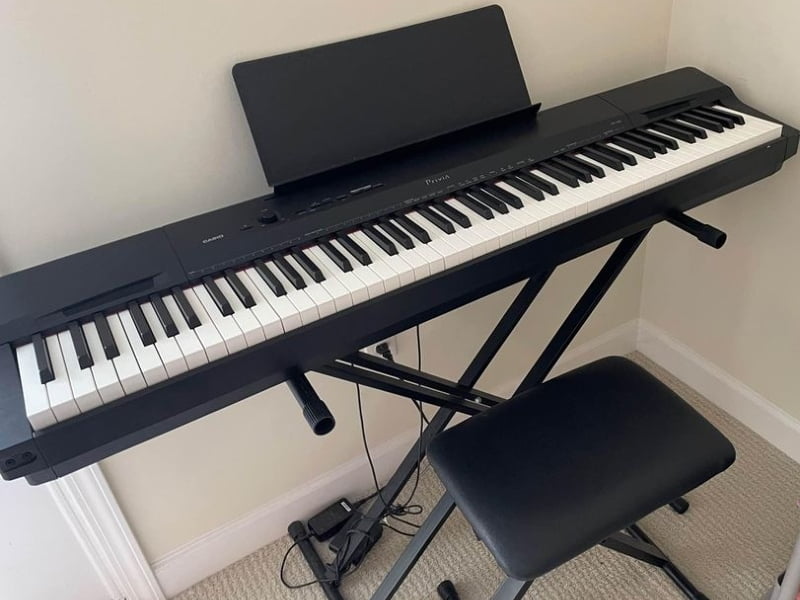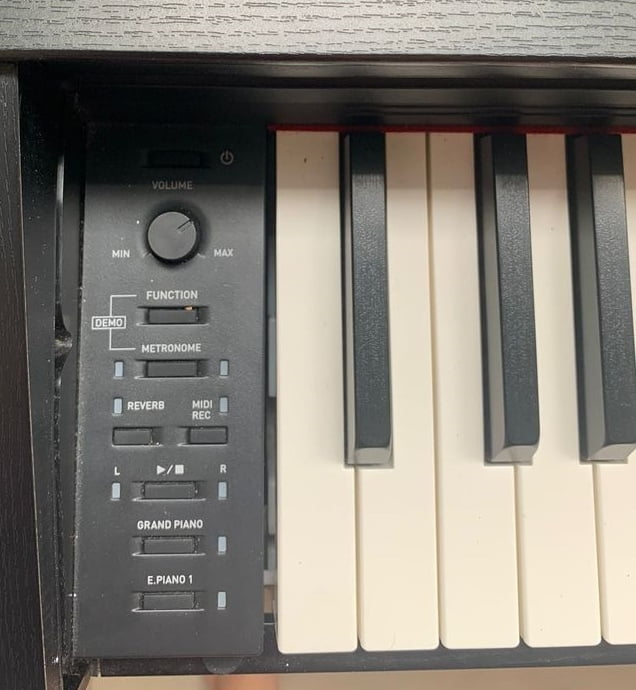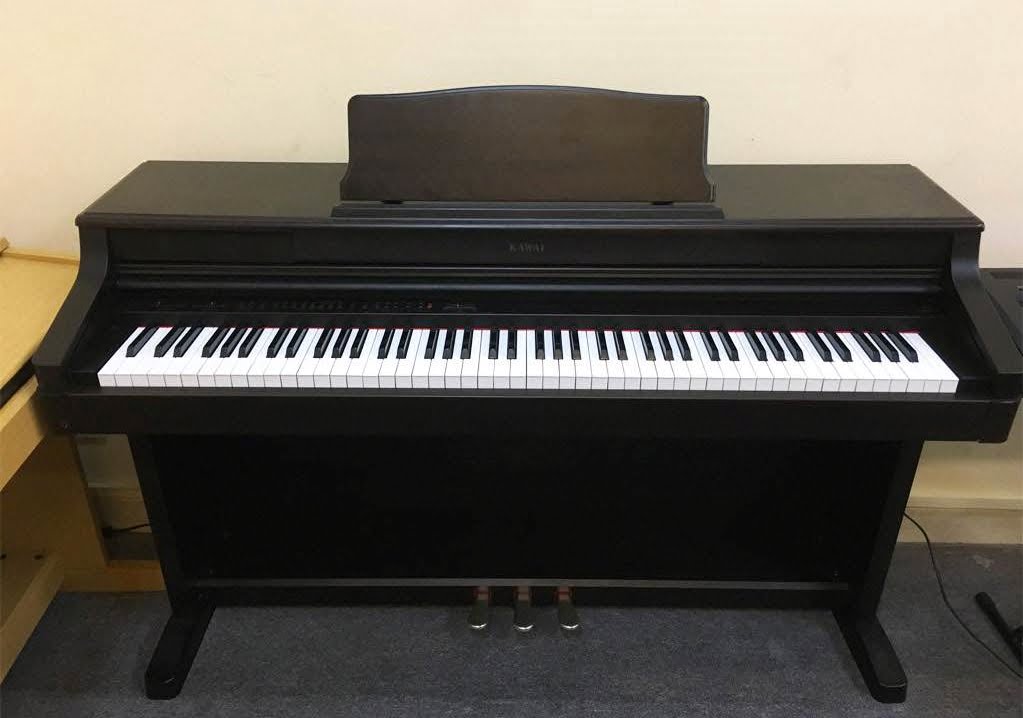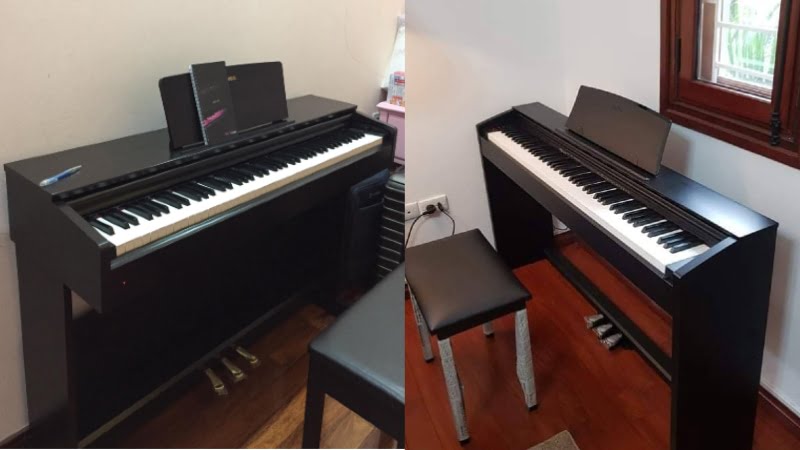Discover the best digital piano for you in this Casio PX-770 vs PX-160 comparison!
The Casio Privia line contains some of the best budget digital pianos. And today, we’ll be comparing one of their console pianos against one of their portable options in this Casio PX-770 vs PX-160 review.
I usually prefer portable over console options. This is because they offer more versatility. However, in this comparison, the Casio PX-770, the console digital piano, ended up winning. While the Casio PX-160 offers some of the best functionality in its price range, the PX-770 comes with a range of features you can’t avoid.
Both pianos have a lot to offer, which is why I made this comprehensive comparison. Below, we’ll get into more detail about both pianos. We’ll talk about their features, benefits, drawbacks, and more.
That way, by the end of this review, you’ll know exactly which piano is the best fit for your needs.
Casio PX-770 vs PX-160: Comparison Chart


Last update on 2025-06-25 / Affiliate links / Images from Amazon Product Advertising API
Casio PX-770 vs PX-160: A Head-to-Head Comparison
To find an objective winner between the two, I compared them based on three specific criteria. These are what I believe to be the most important features of a digital piano, which are the tone, feel, and extra piano features. After each comparison point, I awarded a point to whichever piano I believed to be the winner.
At the end of this comparison, the score was 3-2 in favor of the Casio PX-770. As I mentioned earlier, the Casio PX-770 was the definite winner in this comparison, but only by slim margins. In this section, I’ll explain all the features of both pianos, so you’ll know why I ended up choosing the Casio PX-770 as the winner.
Tone
The winner: Tie
When it came down to the tone, I couldn’t pick a winner. This is because the Casio PX-770 and the PX-160 come with the same tone engine and a very similar sound library. I will say that the PX-770 has a slight advantage because of one extra voice, but it wasn’t enough to push it over the top. So, for this comparison, I gave the point to both pianos.
+Tone Generator
Like many Privia models in this price range, both the Casio PX-770 and the PX-160 come with the AiR Sound Source. This is a step up above basic digital pianos that utilize poorly recorded samples for their tone. While the AiR Sound Source also uses samples, you’ll notice that the samples are much better than what you’d expect in this price range.
This is because the AiR Sound Source uses multi-dimensional stereo samples. These recordings contain much more detail and nuance compared to the other pianos in this price range, which is why both pianos stand out.
When you play either piano, you can expect some very high-quality and realistic tones. Whether you utilize the classic grand and electric piano voices or try out the organ and strings samples, you can expect a level of realism that’s largely unseen in this price range.

+Sound Library
Since these are entry-level digital pianos; they don’t have the widest sound libraries. Most digital pianos in this price range highlight quality over quantity. So, while you won’t have the widest array of voices with these pianos, you can expect each of the voices to be of the highest-quality in the price range.
The Casio PX-160 comes with 18 voices. This includes a couple of acoustic pianos, electric piano, strings, bass, synth, organ, and strings voices. These are all the essentials for beginner and novice pianos, and you’ll be able to play various genres with these tones.
On the flip side, the Casio PX-770 comes with 19 voices. This is only one more than the PX-160, so it wasn’t enough to give it the point. However, take note that the PX-770 comes with one extra grand piano voice that can compete with models twice its price.
Since the PX-770 is a console digital piano, it’s designed to offer more realism. This is why it comes with an extra grand piano tone that is about the closest you’ll get to an acoustic piano’s sound in this price range.
Feel
The winner: Casio PX-770
The next comparison point I had was the feel. And since the Casio PX-770 is a console digital piano, you shouldn’t be surprised that it wins the point. After all, console pianos are supposed to feel much more realistic compared to portable options, so there was no doubt in my mind that the Casio PX-770 would win this point.
+Hammer Action
Both of these pianos have decent hammer action systems. The PX-160 comes with hammer action keys. This means that all of the keys are weighted and have a decent spring back to them to replicate an acoustic piano. And while it does a pretty good job, I felt like I was missing some detail when testing out this piano.
On the other hand, the Casio PX-770 easily wins out with the Scaled Hammer Action II system. This hammer action system replicates the feel of an acoustic piano by adding a bit more weight to the bass keys compared to the treble keys. This is the way the hammer action of an acoustic piano works, so it was very nice for Casio to include that small detail.
Additionally, I noticed that the Casio PX-770’s keys sprung back a bit better than the PX-160. This was a very small difference that most people won’t notice. However, this was another reason I believe that the Casio PX-770 felt more realistic than the PX-160.

Piano Features
The winner: Tie
The last comparison point I had was the piano features. And since I told you the score earlier, you should know that the point went to both pianos. With the same polyphony and playing modes, there was no clear winner when focusing on this comparison point.
+Polyphony
Both pianos have 128-note maximum polyphony. This is great for the price as not all pianos have this polyphony when shopping in this range. This means that you can play up to 128 notes at the same time with these pianos. While you won’t be playing 128 keys at the same time, this comes in handy when blending voices or using the sustain pedal to add more emotion and expression to your playing.
+Playing Modes
Both these pianos come with lesson and dual mode. With lesson mode, you can divide the piano into two mini keyboards with the same sounds. As you might guess, this mode is used for piano lessons as it allows you and the piano teacher to play along with each other using the same piano.
With dual mode, you can blend two voices on the piano. This allows you to create unique tones that are perfect for your playing style. This also lets you experiment with different sounds and find something that fits your playing style exactly.
While it would have been nice to also see a split mode on this piano, it’s understandable when you look at the price point.

Casio PX-770 vs PX-160: The Similarities
Aside from the polyphony and additional playing modes, these pianos share a couple of similarities. To start, they come from the same product line. The Casio Privia collection is known to be the perfect balance between quality and price. So, you can expect either of these pianos to offer a lot of value for the money which you won’t usually be able to find at this price point.
While one is a portable instrument and the other stays in one place, you can expect both of them to deliver top-quality tones. I was honestly very surprised when testing these pianos out because of how well they replicate the sound and feel of an acoustic piano.
It was hard to pick a winner, but the Casio PX-770 eventually showed its superiority. It’s slightly more expensive than the PX-160, but I can confidently say that the extra price is worth it due to the great features that come with the piano.
Quick Rundown of the Casio PX-770
- IMMERSIVE GRAND PIANO SOUND – Award-winning AiR Sound Source with stereo grand piano, damper resonance, and 19 tones for rich, expressive performances.
- REALISTIC TOUCH & FEEL – 88-key Tri-Sensor II Hammer Action with ebony/ivory-feel keys, adjustable touch sensitivity, and hammer response.
- CLEAR, POWERFUL AUDIO – Built-in stereo speaker system delivers detailed, balanced sound across the full range.
- BUILT FOR LEARNING – Duet Mode, dual headphone jacks, 60 built-in songs, MIDI recorder, and Concert Play orchestral backing tracks.
- SLIM, STYLISH DESIGN – Elegant cabinet with sliding key cover fits any décor. USB-MIDI port connects easily to Mac, PC, iOS, or Android—no drivers needed.
Last update on 2025-06-25 / Affiliate links / Images from Amazon Product Advertising API
Quick Rundown of the Casio PX-160
- Thanks to the new speaker system (2 x 8 watts) for maximum hearing pleasure when playing alone at home and the new line-out slot for simple connection to external loudspeakers (on stage, in a practice room or at home)
- The pure functions produced by the digital piano make its 18 authentic piano tones sound even better to the ear
- Launching into multi-dimensional AiR sound generation becomes a pleasure with the new PX-160. Keyboard: 88 keysweighted scaled hammer action 3 sensitivity levels, offSimulated ebony and ivory keys
- 3 year manufacturer extended warranty.Hall Simulator/Reverb - 4 (Reverb) Chorus - 4 Brilliance - -3 ~ 0 ~ +3DPS - Yes (Preset for some tones).
- On Stage Classic Single-X Keyboard Stand and Top Stage leather padded piano keyboard bench.Multi-dimensional Morphing AiR Sound SourceStereo-sampled Piano Tones
Last update on 2025-06-25 / Affiliate links / Images from Amazon Product Advertising API
Product Video
Related Articles to Casio Px 770
- Casio PX-770 vs Korg B2SP: A Battle of Budget Console Digital Pianos?
- Casio PX-770 vs Kawai KDP-110: The Best Console Digital Pianos on a Budget?
- Casio PX-770 vs Kawai ES-110: Should You Get A Portable or Console Digital Piano?
- Casio PX-770 vs S1000: Should You Get A Portable or Console Digital Piano?
- Casio PX-770 vs 750: Finding the Best Budget Digital Piano
- Casio PX-770 vs PX-860: Should You Get A Portable or Console Digital Piano?
- Casio PX-770 Vs AP-270: Which Casio Model Wins Out?
- Casio PX-770 Vs 760: Which Is The Better Casio Privia Model?
- Casio PX-770 Vs Yamaha DGX-660: Should You Get A Portable Or Console Digital Piano?
- Casio PX-770 Vs Yamaha YDP-143: Which Is The Better Piano For The Money?
- Casio PX-770 Vs Roland FP-30: Should You Get A Portable or Console Digital Piano?
- Casio PX-770 vs Yamaha YDP-144: Which Is The Better Digital Piano?
- Casio PX-770 Vs 780: What’s The Difference Between These Two Digital Pianos?
- Casio PX-770 Vs 870: Which Casio Console Digital Piano Is Better?
- Yamaha P45 vs Casio PX 770: Should You Get the Portable or Console Digital Piano?
- Yamaha P125 vs Casio PX-770 Review: Why the Yamaha P125 Beats Out the Casio Console Digital Piano
Related Articles to Casio Px 160
References:
- Casio PX-770: https://www.sweetwater.com/store/detail/PX770BK–casio-privia-px-770-black-finish
- Casio PX-160: https://www.casio-intl.com/asia/en/emi/products/px160/spec/
Lulacruza is an electronic folk duo operating at the junction of the hypermodern and the ancient. Our music weaves together hypnotic female singing, South American folk instruments and electronic processing, while channeling pulsating waves from the source of creation.
Lalucruza is also a community where you can connect with other music lovers to collaborate, exchange ideas and share knowledge. A platform for who wants to learns the basics of playing piano, guitar, drum masters’ technique, etc.. is the premise of our website.
